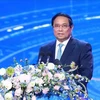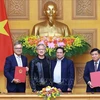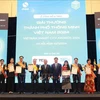As Ho Chi Minh City residents and businesses dump huge volumes of waste every day, authorities are exploring ways to generate energy from waste.
A report by the Department of Natural Resources and Environment said efforts have been made to generate power and collect methane from landfills around the city.
Dr Nguyen Trung Viet, head of the department's Solid Waste Management Division, said a power generation facility based in the Go Cat landfill since 2005 had been generating 0.95MW. It has a capacity of 25MW.
Go Cat is among the five rubbish dumps that have been closed, the others being Dong Thanh, Phuoc Hiep 1, Phuoc Hiep, and Da Phuoc.
Viet said the energy potential of land-fill waste, including by using gases collected from them, burning waste for electricity, and collecting methane for fuel, was huge since the city generated around 7,500 tonnes of solid waste every day.
"Producing renewable energy from waste is economically and technically feasible when the waste is highly bio-degradable and contains moisture," he said.
"Gases emitted by landfills contain around 65 percent methane.
"The city endures the pollution from waste for a long time and spends more than 700 billion VND (34 million USD) each year to treat waste. It means the city has wasted thousands of billions of dong to destroy sources of renewable energy."
Keppel Seghers of Singapore and the local Tam Sinh Nghia Joint-stock Company plan to build two power plants operated by burning solid waste which can generate a combined 80MW.
Each plant will use 2,000 tonnes of waste a day at full capacity.
Viet said the city was seeking investment in generating energy from waste, and several companies from the US and the Republic of Korea were interested. The projects have been held up only because of the low price of 4 cent for a KWh of electricity offered by the Electricity of Vietnam (EVN), he said.
Addressing a workshop on the development of HCM City into a low-carbon society, Prof Seiichi Ishikawa of the Japanese University of Kitakyushu's environmental engineering faculty said the city should have a better collection system to achieve the 3R's – recycle, reuse, and reduce.
That would help improve treatment at the landfills for energy recovery, he added./.
A report by the Department of Natural Resources and Environment said efforts have been made to generate power and collect methane from landfills around the city.
Dr Nguyen Trung Viet, head of the department's Solid Waste Management Division, said a power generation facility based in the Go Cat landfill since 2005 had been generating 0.95MW. It has a capacity of 25MW.
Go Cat is among the five rubbish dumps that have been closed, the others being Dong Thanh, Phuoc Hiep 1, Phuoc Hiep, and Da Phuoc.
Viet said the energy potential of land-fill waste, including by using gases collected from them, burning waste for electricity, and collecting methane for fuel, was huge since the city generated around 7,500 tonnes of solid waste every day.
"Producing renewable energy from waste is economically and technically feasible when the waste is highly bio-degradable and contains moisture," he said.
"Gases emitted by landfills contain around 65 percent methane.
"The city endures the pollution from waste for a long time and spends more than 700 billion VND (34 million USD) each year to treat waste. It means the city has wasted thousands of billions of dong to destroy sources of renewable energy."
Keppel Seghers of Singapore and the local Tam Sinh Nghia Joint-stock Company plan to build two power plants operated by burning solid waste which can generate a combined 80MW.
Each plant will use 2,000 tonnes of waste a day at full capacity.
Viet said the city was seeking investment in generating energy from waste, and several companies from the US and the Republic of Korea were interested. The projects have been held up only because of the low price of 4 cent for a KWh of electricity offered by the Electricity of Vietnam (EVN), he said.
Addressing a workshop on the development of HCM City into a low-carbon society, Prof Seiichi Ishikawa of the Japanese University of Kitakyushu's environmental engineering faculty said the city should have a better collection system to achieve the 3R's – recycle, reuse, and reduce.
That would help improve treatment at the landfills for energy recovery, he added./.



















